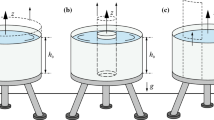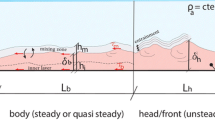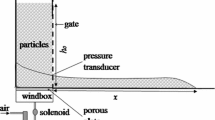Abstract
In order to simulate a simple entraining geophysical flow, a viscous Newtonian gravity current is released from a reservoir by a dam-break and flows along a rigid horizontal bed until it meets a layer of entrainable material of finite depth, identical to the current. The goal is to examine the entrainment mechanisms by observing the interaction between the incoming flow and the loose bed. The sole parameter varied is the initial volume of the gravity current, thus altering its height and velocity. The gravity current plunges or spills into the entrainable bed and the velocity of the flow front becomes linear with time. The bed material is directly affected: motion is generated in the fluid far downstream of, and in that lying beneath the encroaching front. Shear bands are identified, separating horizontal flow downstream from flow with a strong vertical component close to the step. Downstream of the step the flow is horizontal and stratified, with no slip on the bottom boundary and very low shear near the surface. Between these two regions may lie transitional zones with linear velocity profiles, separated by horizontal bands of high shear; the number of transitional zones in the cross-section varies with the initial volume of the dam-break.










Similar content being viewed by others
References
Adduce C, Sciortino G, Proietti S (2012) Gravity currents produced by lock-exchanges: experiments and simulations with a two layer shallow-water model with entrainment. J Hydraul Eng 138(2):111–121
Ancey C, Gervasoni C, Meunier M (2004) Computing extreme avalanches. Cold Reg Sci Technol 39:161–180
Andreini N (2012) Dam break of Newtonian fluids and granular suspensions. PhD Thesis, EPFL, Switzerland
Andreini N, Epely-Chauvin G, Ancey C (2012) Internal dynamics of Newtonian and viscoplastic fluid avalanches down a sloping bed. Phys Fluids 24(5):053101
Barbolini M, Biancardi A, Cappabianca F, Natale L, Pagliardi M (2005) Laboratory study of erosion processes in snow avalanches. Cold Reg Sci Technol 43(1–2):1–9
Berger C, McArdell BW, Schlunegger F (2011) Direct measurement of channel erosion by debris flows, Illgraben, Switzerland. J Geophys Res 116:F01002
Cannon SH, Savage WZ (1988) A mass-change model for the estimation of debris-flow runout. J Geol 96(2):221–227
Chen H, Crosta GB, Lee CF (2006) Erosional effects on runout of fast landslides, debris flows and avalanches: a numerical investigation. Geotechniques 56(5):305–322
Delannay R, Louge M, Richard P, Taberlet N, Valance A (2007) Towards a theoretical picture of dense granular flows down inclines. Nat Mater 6(2):99–108
Egashira S, Itoh T, Takeuchi H (2001) Transition mechanism of debris flows over rigid bed to over erodible bed. Phys Chem Earth B 26(2):169–174
Eglit ME, Demidov KS (2005) Mathematical modeling of snow entrainment in avalanche motion. Cold Reg Sci Technol 43(1–2):10–23
Estep J, Dufek J (2012) Substrate effects from force chain dynamics in dense granular flows. J Geophys Res 117:F01028
Gauer P, Issler D (2004) Possible erosion mechanisms in snow avalanches. Ann Glaciol 38:384–392
Gray JMNT (2001) Granular flow in partially filled slowly rotating drums. J Fluid Mech 441:1–29
Hungr D, Evans SG (2004) Entrainment of debris in rock avalanches: an analysis of a long run-out mechanism. Geol Soc Am Bull 116(9–10):1240–1252
Huppert HE (1982) The propagation of two-dimensional and axisymmetric viscous gravity currents over a rigid horizontal surface. J Fluid Mech 121:43–58
Iverson RM (2012) Elementary theory of bed-sediment entrainment by debris flows and avalanches. J Geophys Res 117:F03006
Iverson RM, Reid ME, Logan M, LaHusen RG, Godt JW, Griswold JP (2011) Positive feedback and momentum growth during debris-flow entrainment of wet bed sediment. Nat Geosci 4(2):116–121
Le L, Pitman EB (2009) A model for granular flows over an erodible surface. SIAM J Appl Math 70(5):1407–1427
Luna BQ, Remaitre A, van Asch TWJ, Malet JP, van Westen CJ (2012) Analysis of debris flow behavior with a one dimensional run-out model incorporating entrainment. Eng Geol 128:63–75
Mangeney A, Tsimring LS, Volfson D, Aranson IS, Bouchut F (2007) Avalanche mobility induced by the presence of an erodible bed and associated entrainment. Geophys Res Lett 34:L22401
Mangeney A, Roche O, Hungr O, Mangold N, Faccanoni G, Lucas A (2010) Erosion and mobility in granular collapse over sloping beds. J Geophys Res 115:F03040
McCoy SW, Kean JW, Coe JA, Tucker GE, Staley DM, Wasklewicz TA (2012) Sediment entrainment by debris flows: in situ measurements from the headwaters of a steep catchment. J Geophys Res 117:F03016
McDougall S, Hungr O (2005) Dynamic modelling of entrainment in rapid landslides. Can Geotech J 42(5):1437–1448
Melosh HJ (1986) The physics of very large landslides. Acta Mech 64:89–99
Moffatt HK (1964) Viscous and resistive eddies near a sharp corner. J Fluid Mech 18:1–18
Pierson TC (1995) Flow characteristics of large eruption-triggered debris flows at snow-clad volcanos—constraints for debris-flow models. J Volcanol Geotherm Res 66(1–4):283–294
Schurch P, Densmore AL, Rosser NJ, McArdell BW (2011) Dynamic controls on erosion and deposition on debris-flow fans. Geology 39(9):827–830
Skeel RD, Berzins M (1990) A method for the spatial discretization of parabolic equations in one space variable. SIAM J Sci Stat Comput 11:132
Sovilla B, Bartelt P (2002) Observations and modelling of snow avalanche entrainment. Nat Hazards Earth Syst Sci 2:169–179
Sovilla B, Sommavilla F, Tomaselli A (2001) Measurements of mass balance in dense snow avalanche events. Ann Glaciol 32:230–236
Sovilla B, Burlando P, Bartelt P (2006) Field experiments and numerical modeling of mass entrainment in snow avalanches. J Geophys Res 111:F03007
Sveen JK (2004) An introduction to matpiv v. 1.6.1. Technical report, University of Oslo
Acknowledgments
This work was supported by funding from Ecole Polytechnique Fédérale de Lausanne. Many thanks to Nicolas Andreini, Gaël Epely-Chauvin and Bob de Graffenried for their help and guidance during this project.
Author information
Authors and Affiliations
Corresponding author
Rights and permissions
About this article
Cite this article
Bates, B., Ancey, C. & Busson, J. Visualization of the internal flow properties and the material exchange interface in an entraining viscous Newtonian gravity current. Environ Fluid Mech 14, 501–518 (2014). https://doi.org/10.1007/s10652-013-9297-0
Received:
Accepted:
Published:
Issue Date:
DOI: https://doi.org/10.1007/s10652-013-9297-0




